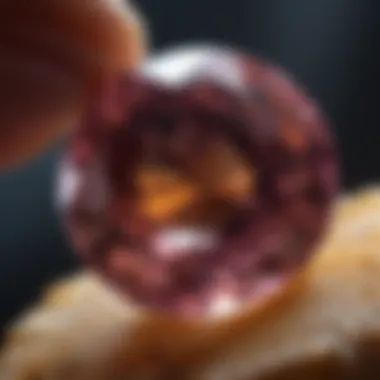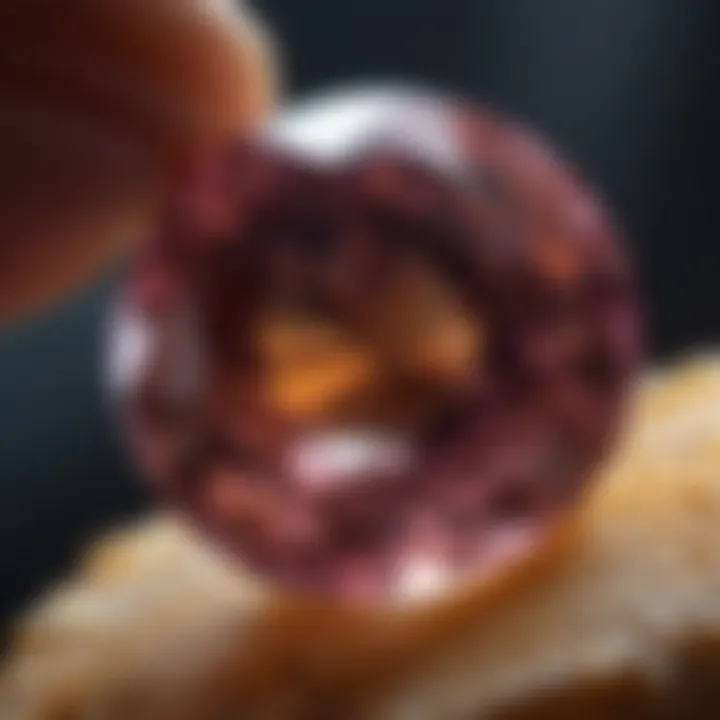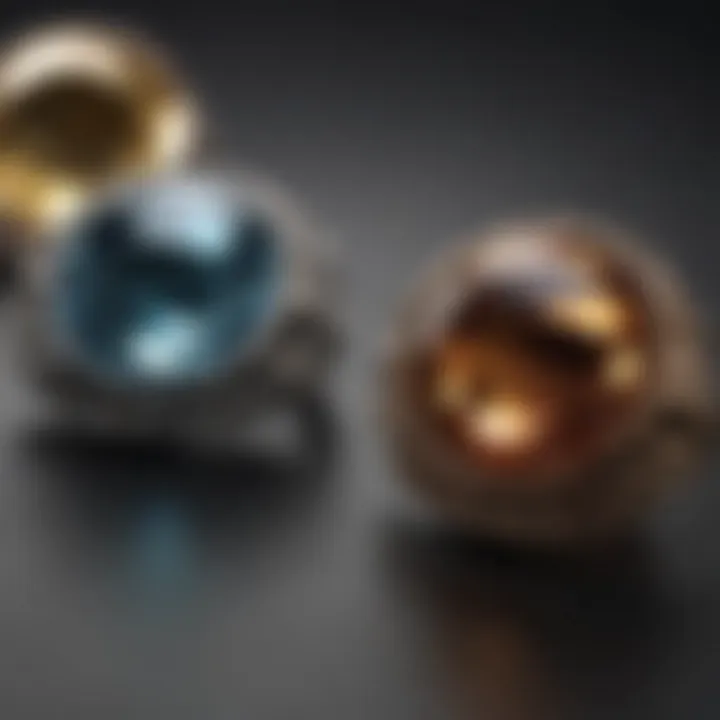Exploring Peak Lupe: A Multidimensional Analysis


Intro
In the intricate world of gemology, the tools employed to evaluate and understand gemstones are as important as the gems themselves. One such essential tool is the Peak Lupe 10x, a magnifying device designed to offer significant insights into the structure and characteristics of gemstones. This article, through a multidimensional analysis, aims to explore the various facets of the Peak Lupe 10x, unveiling its mechanics, applications, and broader significance in the field.
The analysis will guide gemstone enthusiasts, collectors, jewelry designers, and geology enthusiasts through the relevance of the Peak Lupe 10x in both professional and hobbyist realms. The discussion will encompass not just its functionality but also the historical context and advancements in loupe technology.
By synthesizing this information, the article seeks to provide a comprehensive understanding of how the Peak Lupe 10x enhances gem assessment and appreciation.
Gemstone Overview
Definition and Characteristics
A gemstone is defined as a precious or semi-precious mineral that has been cut and polished for ornamental use. Its characteristic features include a distinct color, luster, clarity, and hardness. Each gemstone presents unique attributes which not only add to its beauty but also determine its value in the market. Common characteristics often evaluated include:
- Color: The most significant factor in gemstone identification. Color can vary widely within the same mineral.
- Clarity: This refers to the presence of inclusions or blemishes. The clearer a gemstone, the more valuable it is generally considered.
- Cut: This involves how a gemstone is shaped. The quality of the cut impacts how light interacts with the stone, influencing its brilliance.
- Carat Weight: This is a measurement unit that indicates the weight of the gemstone, significantly affecting its price.
Classification of Gemstones
Gemstones are classified into various categories based on their composition, formation, and characteristics. The primary classifications include:
- Precious Gemstones: These are considered the most valuable. Examples include diamonds, rubies, sapphires, and emeralds.
- Semi-Precious Gemstones: These are less valuable but still highly sought after. Examples are amethyst, turquoise, and garnet.
- Organic Gemstones: These originate from living organisms. Notable examples are pearls, coral, and amber.
- Synthetic Gemstones: Artificially created in laboratories, they possess the same chemical composition as natural stones.
Understanding these classifications helps enthusiasts and professionals alike in making informed decisions regarding purchases and appraisals.
Historical Significance
Ancient Uses and Cultural Importance
Gemstones have held significant cultural value throughout human history. Ancient civilizations, from the Egyptians to the Aztecs, have documented the use of gemstones in fashion, art, and rituals.
- In ancient Egypt, turquoise was considered a symbol of life and fertility, often set into tombs.
- The Aztecs valued emeralds for both decorative and spiritual purposes, associating them with nature and renewal.
Myths and Legends Surrounding Gemstones
Numerous myths and legends weave around gemstones, enhancing their allure. Stories often depict gemstones as talismans offering protection, wisdom, or even healing properties. For example:
"The ancient Greeks believed that wearing an amethyst could prevent intoxication and promote clarity of thought."
These narratives not only represent a rich tapestry of cultural beliefs but also contribute to the perceived value and desirability of these natural wonders.
In summary, the Peak Lupe 10x plays a crucial role in unveiling the intricate details and stories behind gemstones. This multidimensional analysis ensures a deeper understanding of both the tool and the gemological treasures it helps to assess.
Prologue to Peak Lupe 10x
The examination of Peak Lupe 10x is crucial for those who are heavily engaged in gemology. This tool represents a blend of precision and practicality in gemstone evaluation. Peak Lupe 10x stands out not just for its magnification power but also for its ergonomic design and versatility. Understanding its elements and benefits helps both professionals and hobbyists maximize their gem assessment skills.
Definition and Purpose
Peak Lupe 10x is a specialized handheld magnifying tool that provides 10 times magnification of gems and other small objects. Its primary purpose is to facilitate a detailed evaluation of gemstones, enabling users to identify unique characteristics like clarity, color, and imperfections. This level of examination is critical in establishing the value and authenticity of gemstones. Furthermore, the simplicity of its design allows it to be both portable and easy to use. This tool is invaluable for jewelers, collectors, and gem enthusiasts aiming for precise observations with ease.
Overview of Gemology Tools
In gemology, numerous tools assist in the evaluation and authentication of gemstones. Beyond the Peak Lupe 10x, other significant tools include refractometers, microscopes, and spectroscopes. Each of these plays a vital role in the gemologist's kit, offering various insights into gem quality.
- Refractometers measure the refractive index of the gem, providing insight into its optical properties.
- Microscopes enable an even more detailed inspection, suitable for examining inclusions and surface features.
- Spectroscopes analyze light interaction with gemstones, helping in color and chemical composition analysis.
Emphasizing the right tool for the right job ensures accurate assessments in gemology. The Peak Lupe 10x, with its compactness and clarity, is often a first choice for many professionals looking to quickly appraise gemstones on the go.


Historical Context of Loupes
Understanding the historical context of loupes is crucial to appreciate the Peak Lupe 10x and its role in the gemology field today. This section elaborates on the various phases of evolution in magnification techniques and the significant breakthroughs in gemology that have defined the industry.
Evolution of Magnification Techniques
The journey of magnification began centuries ago with simple magnifying glasses made from glass lenses. These early tools were rudimentary, often causing distortion and limiting clarity. The need for precise inspection of gemstones arose with increasing trade in precious stones. Over time, advancements in lens crafting techniques led to the development of more sophisticated optical instruments.
In the late 19th century, innovations such as the triplet lens emerged, allowing for clearer and less distorted images. This marked a pivotal moment in gemological practice, offering gemologists a way to evaluate gemstones with increased precision. The invention of loupes, specifically, addressed the unique challenges posed by gemstone assessment. They offered portability and convenience, enabling professionals to work effectively in various settings.
Recent developments have introduced advanced materials into lens construction. Optical-grade glass and synthetic materials reduce chromatic aberration, enhancing overall visual fidelity. Such innovations have revolutionized the loupe landscape, setting the stage for specialized tools like the Peak Lupe 10x.
Key Developments in Gemology
Gemology is shaped by several key milestones in its history. The establishment of organizations such as the Gemological Institute of America (GIA) in the 1930s cemented the standards for gem classification and evaluation processes. This was a foundational change, leading to the formalization of gemological study.
Technological advances, including laser cutting and digital imaging, further shifted gemology into a more scientific discipline. These technologies allowed for deeper insights into gemstone structures and characteristics, overcoming limitations imposed by traditional hand-held tools.
"The evolution of loupes is not just about magnification—it's fundamentally about improving the accuracy of gemstone evaluation and enhancing the overall consumer trust in gem purchases."
In summary, understanding the historical context of loupes allows gemstone enthusiasts and professionals to appreciate the Peak Lupe 10x not just as a tool but also as a culmination of centuries of optical innovation and gemological advancement. Recognizing its importance underscores the role of precision in gem assessment, which is vital in today's market.
Technical Features of Peak Lupe 10x
The technical features of the Peak Lupe 10x serve as its backbone, defining its efficiency and usability in the niche of gemology. A solid understanding of these features can greatly enhance the way gemstones are evaluated. Key aspects such as magnification power and lens quality are crucial for users ranging from hobbyists to seasoned professionals. Their roles directly impact the clarity of details that gemologists can observe, making these features foundational to the Peak Lupe’s effectiveness.
Magnification Power Explained
Magnification power refers to how much larger an object appears when viewed through the loupe. The Peak Lupe 10x indicates that objects will appear ten times larger than their actual size. This level of magnification is significant for several reasons.
First, it allows for a detailed examination of a gemstone's surface. Users can spot imperfections, scratches, or inclusions that are not visible to the naked eye. Recognizing such characteristics is essential in assessing a gemstone's overall clarity and quality. This precision is especially important in the highly competitive gem market where even tiny flaws can substantially affect a gem's value.
Second, higher magnification levels, like 10x, promote the evaluation of intricate cuts and facets in gemstones. The clearer insight into these details aids jewelers and buyers in determining whether a stone's cut meets industry standards. The increase in perceived detail translates into more informed decisions during purchases or appraisals, establishing the Peak Lupe 10x as an indispensable gemological tool.
Lens Quality and Construction
The manufacturing quality of the lens is equally significant as magnification power. Peak Lupe utilizes high-grade optical glass, which minimizes distortion. This quality is critical because any level of distortion can misrepresent a gemstone's true colors and visibility of imperfections.
Construction techniques also play a vital role. Many loupes feature multi-coated lenses, which reduce glare and enhance light transmission. Improved light flow leads to brighter and clearer views, making it easier for users to conduct thorough inspections.
Furthermore, the ergonomic design of Peak Lupe means that it can be comfortably held for prolonged periods, which is often necessary during detailed inspections. The durable casing protects the lenses from damage, ensuring long-term reliability. Thus, investing in a Peak Lupe means prioritizing lens quality and construction, which ultimately enables a higher standard of gemstone evaluation.
Understanding the technical features of the Peak Lupe 10x is not just about its specifications; it is about recognizing how these specifications enhance the precision of gemstone analysis.
Applications in Gemstone Evaluation
Gemstone evaluation is a critical process that requires accuracy and precision. The Peak Lupe 10x plays an essential role in this evaluation, providing gemologists with a reliable tool to inspect gemstones closely. Its capabilities allow for a comprehensive analysis of various gemstone characteristics, ensuring that decisions made regarding quality, value, and overall aesthetics are well-informed. The importance of this section is in understanding how the Peak Lupe 10x assists users in identifying important attributes of gemstones, guiding the assessment process with clarity and ease.
Assessing Clarity and Inclusions
Clarity refers to the presence of internal or external flaws in a gemstone. These flaws, known as inclusions and blemishes respectively, can significantly affect a gemstone's appearance and value. Using the Peak Lupe 10x allows gemologists to closely examine the clarity of a gemstone. With its 10x magnification, even subtle inclusions become visible. The higher magnification enables users to see details that would otherwise remain hidden.
When assessing clarity:
- Identify Types of Inclusions: Recognizing different types of inclusions helps in grading a gemstone's clarity accurately. For instance, crystals, feathers, and needles can be assessed through the lens of a loupe.
- Determine Location of Inclusions: Some inclusions are less detrimental to value when located near the base of a stone rather than in the center. A Peak Lupe can assist in locating these flaws efficiently.
- Evaluate Size and Number: Large or numerous inclusions typically reduce a gemstone's value. Careful assessment through the loupe can clarify how these factors impact the gemstone’s worth.
Determining Cut Quality


The cut of a gemstone is crucial in defining its beauty and brilliance. The Peak Lupe 10x serves to evaluate how effectively a gemstone has been cut. A well-cut gemstone reflects light beautifully. During inspection, gemologists can focus on several cut characteristics:
- Symmetry: The loupe allows for a close examination of the gemstone's proportions. Symmetrical stones tend to reflect light effectively, enhancing their appeal.
- Faceting: Each facet can be evaluated individually, enabling a comprehensive overview of craftsmanship. Varying facet angles can influence light reflection.
- Polish Quality: Surface quality can be scrutinized; a poorly polished stone will not shine as bright. Inspecting for scratches or uneven surfaces helps assess the cut quality as well.
Color Examination Techniques
Color is one of the most noticeable attributes in gemstones and can dictate their desirability and value. The Peak Lupe 10x provides a means to examine color nuances that could be missed by the naked eye. Through color assessment, gemologists can understand:
- Color Tone: Determining the intensity and shade of color helps professionals classify gemstones correctly.
- Color Zoning: Some gemstones exhibit color zoning where different areas show varying colors. Observing these zones provides insights into the quality and appeal of the stone.
- Saturation Levels: The loupe aids in identifying saturation levels, impacting how vibrant or dull a gemstone appears.
The Peak Lupe 10x empowers gemologists by allowing them to draw meaningful conclusions based on observable characteristics, enhancing the overall gemstone evaluation process.
Comparison with Other Gemological Tools
The comparison of Peak Lupe 10x with other gemological tools is critical in understanding its unique benefits and applications in gemstone evaluation. Each tool serves a distinct purpose, and knowing the differences can assist users in selecting the right equipment for their needs. This section will examine how Peak Lupe differentiates itself, especially when contrasted with microscopes and various types of loupes.
Differences between Loupes and Microscopes
Loupes and microscopes are both essential in gemology but operate at different levels of magnification and detail. A loupe, such as the Peak Lupe 10x, typically provides a lower magnification level that is suitable for quick inspections and assessments. This tool excels in portability and ease of use, allowing gemologists to assess stones on-the-go. In contrast, microscopes offer higher magnification and detailed imaging, which is beneficial for in-depth analysis of gemstones. However, they can be bulky and require a stable working surface, limiting their casual usage.
Some key distinctions include:
- Magnification Power: Loupes like Peak Lupe provide sufficient magnification for most gem evaluation tasks while microscopes are used for examining intricate inclusions.
- Portability: The lightweight design of loupes makes them easy to carry, whereas microscopes generally require a dedicated space.
- User Interaction: Loupes allow for direct observation, offering a hands-on approach. Microscopes necessitate looking through an eyepiece, which may not be as intuitive for every user.
In summary, while both tools are complementary, the choice heavily leans on the context of use. For quick evaluations, the Peak Lupe 10x is ideal, while microscopes serve better for detailed investigations when necessary.
Utility of Handheld Loupes vs. Tabletop Models
When comparing handheld loupes to tabletop models, the user's specific needs should dictate the choice. Handheld loupes, such as the Peak Lupe 10x, offer convenience and flexibility. They are particularly advantageous for gemologists who conduct fieldwork or travel frequently to gemstone markets. Their compact design ensures they are easily transportable and ready for immediate use when assessing various stones.
Tabletop models, on the other hand, provide stability and enhanced clarity due to their fixed position. These devices often come equipped with built-in illumination features which can enhance visibility during inspections. However, their usage is typically limited to stationary environments such as jewelry stores or laboratories.
Consider these points when choosing between the two:
- Flexibility and Use Cases: Handheld loupes are best for mobility, while tabletop models are suited for detailed analysis in controlled settings.
- Comfort: Handheld loupes fit well in one’s hand and allow users to adjust focus easily; tabletop models may require awkward positioning depending on settings.
- Cost Considerations: Handheld loupes, like the Peak Lupe, are generally more affordable than their tabletop counterparts, which can require a significant investment due to their advanced features.
Ultimately, the decision between handheld loupes and tabletop models should align with the user’s evaluation needs, budget, and environment.
User Guidelines for Optimal Use
Using the Peak Lupe 10x effectively requires an understanding of proper techniques as well as maintenance practices. The importance of this section lies in ensuring that users maximize the tool's potential while maintaining its integrity. Poor handling and improper care can lead to inaccurate evaluations and diminished performance over time. With proper guidelines, both hobbyists and professionals can enhance their gem evaluation processes, leading to informed decisions regarding gemstone quality.
Proper Handling Techniques
Proper handling of the Peak Lupe 10x not only contributes to effective gem inspection but also prolongs the life of the tool itself. Here are key techniques to incorporate:
- Grip: Hold the loupe with a steady grip to prevent slipping or dropping it. Using both hands can provide better stability.
- Distance and Angle: Keep the loupe at the correct distance from the eye. Usually, a distance that allows for comfortable viewing of the gemstone without strain is ideal. Adjust the angle of the loupe to focus on different facets of the gemstone.
- Lighting Conditions: Use proper lighting when examining a gemstone. Natural light is often the best choice, but a bright, even artificial light source can also be effective. Ensure that the light source does not create reflections that can distort the view.
- Inspection Technique: Move the loupe around the gemstone slowly to observe different areas without jerky movements. This allows for a smoother viewing experience and a more comprehensive evaluation of the gem’s features, such as inclusions and clarity.
Maintenance and Care Tips
Maintenance and care are critical factors that contribute to the long-term functionality of the Peak Lupe 10x. Ignoring these can lead to scratches on the lens or misalignment, affecting the quality of observations. Follow these tips for maintaining your loupe:
- Cleaning: Use a microfiber cloth to clean the lens. Avoid using any abrasive materials that could scratch the surface. If necessary, a gentle lens cleaning solution can be applied, but make sure to use it sparingly.
- Storage: When not in use, store the loupe in a protective case to prevent damage. Keeping it in a dry, dust-free environment will also help maintain its condition.
- Regular Inspections: Periodically check the loupe for any visible signs of wear or dust accumulation. Addressing minor issues early can prevent larger problems in the future.
- Calibration: If the loupe is equipped with features requiring calibration, consider consulting user manuals or specialists every few years to ensure precision.
Effective use of the Peak Lupe 10x hinges on understanding both its operational aspects and its care. Neglecting these factors may compromise both the tool and the assessment outcomes.
By adhering to these user guidelines, both gemstone enthusiasts and professionals can ensure that they utilize the Peak Lupe 10x to its full potential, preserving its accuracy and longevity for years to come.


Market Trends and Consumer Demand
The study of market trends and consumer demand is essential in understanding the current landscape of gemological tools like the Peak Lupe 10x. This analysis provides insight into how these tools are perceived among professionals and hobbyists alike. As gemology continues to evolve, the demand for effective inspection tools increases. The Peak Lupe 10x is at the forefront of this change, driven by consumer preferences and technological advancements.
In today's market, the focus has shifted towards high-quality, user-friendly equipment. Enthusiasts seek loupes that are not only reliable but also provide enhanced features. The ability to assess gemstones accurately influences purchasing decisions. Thus, understanding the specific needs within this sector is vital. Dealers must be aware of the preferences in terms of magnification, lens clarity, and portability.
Current Market Analysis
Examining the current market reveals significant insights into the popularity of the Peak Lupe 10x among gem enthusiasts and professionals. Sales trends indicate a growing interest in portable, high-quality loupes. This interest is reflected in the rise of e-commerce platforms, where consumers actively seek detailed reviews and comparisons before buying.
The consumer demographic has also evolved. The market includes not only seasoned workers and gemologists but also newer collectors and jewelry designers. They are investing more in reliable tools for evaluations. Brands that offer comprehensive warranties and demonstrate a commitment to quality gain a competitive edge. Furthermore, online forums and communities such as Reddit and Facebook have increased awareness among consumers, inncreasing the demand for quality products.
"Quality and reliability in gemstone assessment tools are paramount to the satisfaction of both professionals and hobbyists."
Investment in Gemological Tools
Investing in gemological tools is not just about purchasing equipment; it reflects an overall commitment to excellence in gemstone evaluation. Professionals understand that effective tools lead to better results, which can translate to higher customer satisfaction. As a result, buyers are willing to spend on high-quality tools like the Peak Lupe 10x, recognizing their long-term value.
This investment has many considerations:
- Budget: Balancing quality with cost is crucial. Buyers often assess their budget before making a significant investment.
- Longevity: Tools that last are more appealing. Consumers tend to prefer durable options that provide consistent accuracy.
- Training and education: As the use of sophisticated tools becomes standard, there is a growing need for education around proper usage and maintenance.
Future of Gemological Inspection Tools
The future of gemological inspection tools holds promising possibilities. Advances in technology will continue to elevate the standards of how gemstones are examined. These developments not only enhance the accuracy of assessments but also improve user experience.
Cost and Efficiency can also be improved through innovation. As techniques advance, we can expect tools that are lighter, easier to handle, and more cost-effective to manufacture. This means that both professionals and hobbyists can access high-quality equipment without exorbitant expense.
The importance of adopting new technologies in gemology is crucial. Without modern tools, evaluations can lag behind in accuracy and reliability.
Advancements in Technology
Recent technological advancements significantly enhance gemological tools, including the Peak Lupe 10x. Optical enhancements are becoming more sophisticated. For example, the integration of digital imaging into magnifying devices allows users to capture high-definition images of gemstones. This leads to better documentation and more precise evaluations.
Additionally, smart technology is entering the gemology field. Devices now often include Bluetooth connectivity, making it easier to transfer images and data to other devices. This connectivity streamlines the assessment process, providing immediate access to records or expert opinions.
Other noteworthy advancements include the development of anti-reflective coatings on lenses, improving visibility and clarity. Improved lens materials provide durability alongside precision. They are more resistant to scratches and degradation, increasing the lifespan of the tools.
Emerging Trends in Gemology
As gemology evolves, several trends are emerging that could impact gemological tools. One major trend is the increased focus on sustainability in the gemstone market. Consumers want assurance regarding the ethical sourcing of their gems. This has pushed manufacturers of gemological tools to adopt sustainable practices in production.
Another trend is the rise of augmented reality (AR) in gemology. While AR technology is still in its infancy within the field, its potential is immense. Gemologists can visualize how a gemstone will appear in different lighting environments or set in various settings before making a purchase.
Furthermore, educational platforms are expanding. They are utilizing technology to offer online courses and resources for both new and seasoned gemologists. These platforms may include interactive tools that allow for hands-on application of the concepts learned, directly impacting how evaluation procedures are taught.
In summary, the future of gemological inspection tools promises a landscape that is not only technologically advanced but also resonates with growing consumer demands for transparency and sustainability.
End
The conclusion encapsulates the significance of the Peak Lupe 10x and its multifaceted applications within gemology. As a tool that helps both professionals and enthusiasts alike assess gemstones, it is critical to understand its features and benefits comprehensively. The insights drawn in the earlier sections showcase how Peak Lupe 10x enhances the clarity of evaluations and supports informed decision-making when selecting gemstones. This aids not just in practical evaluations but also enriches the user's knowledge of gemological properties.
Summarizing Key Findings
Key findings throughout this analysis indicate that the Peak Lupe 10x is more than just a magnifying tool. Its design, quality of lenses, and functional features all contribute to an improved user experience. The exploration of its applications highlights its role in assessing clarity, inclusions, cut quality, and color. Furthermore, the comparison with other gemological tools emphasizes its practical utility, especially for handheld purposes. This makes it a preferred option for quick inspections without sacrificing accuracy.
Final Thoughts on Peak Lupe 10x
In summary, the Peak Lupe 10x stands as an invaluable tool within the realm of gemology. Its continued relevance speaks to the evolving standards of gemstone evaluation. Technological advancements and emerging trends suggest that tools such as the Peak Lupe will only improve in efficiency and effectiveness. Both hobbyists and professionals can benefit greatly from adopting such a high-quality loupe. Investing in this gemological tool not only enhances gemstone evaluation but also complements the overarching pursuit of gemological knowledge. For deeper insights, check out more on Wikipedia or Britannica.
"Understanding and utilizing the right gemological tools can elevate both personal enjoyment and professional capability in gemstone assessment."
Overall, Peak Lupe 10x represents an essential intersection of technology and tradition in gemstone assessment.







